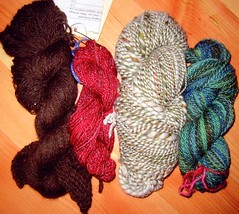 I usually hand people learning to spin Coopworth or Romney; I find they are nice wool to learn with -- any "medium wool" usually is good. Why is it good?
I usually hand people learning to spin Coopworth or Romney; I find they are nice wool to learn with -- any "medium wool" usually is good. Why is it good?- typically, less expensive than dyed wool roving and fine wools
- available in a variety of natural colors
- open crimp, likes to be spun into a visible yarn (LOL as opposed to frog hair) -- easy to spin worsted weight singles
- reasonable staple length, 4-6 inches, usually. Most people when learning will naturally keep at least a hand's width between their hands and adapt to the 6-9 inch separation needed to most easily draft these fibers.
- wool also is easier than non-wool fibers because of the scales on the surface of the wool -- it grabs onto the other fibers and helps keep them together. Mohair, silk, alpaca, cotton don't have these (kinds of) scales and won't grab.
So, whatever you choose -- Romney, BFL, or some other fiber, pick something you'll have fun with, are willing to sacrifice some of (the pile of bits & bobs around me when I was learning how to join -- I laugh at the memory!), and that will help you keep going through the learning process.
Your hands have to learn as much as your head does, ditto feet on a wheel, eyes, and arms. Remember to take breaks and to spread your learning out over time -- give yourself at least a month to get through the wall of learning something totally new, if not longer, even.
Happy spinning!
